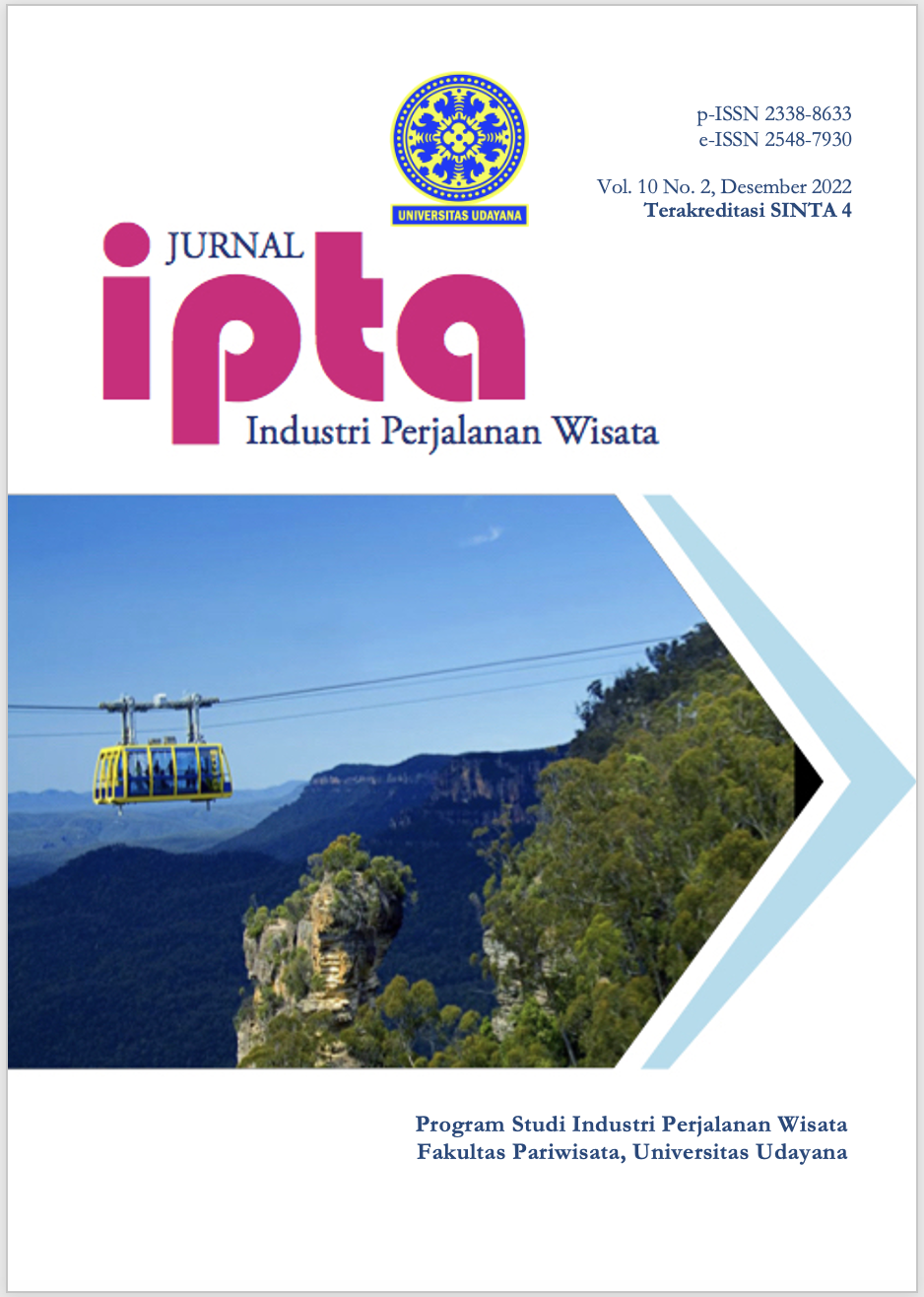POLA PERGERAKAN WISATAWAN NUSANTARA iGENERATION BERWISATA DI BALI PADA MASA PANDEMI COVID-19
Abstract
This writing analyzes how the movement patterns of iGeneration Nusantara who visited Bali during the COVID-19 pandemic. The purpose of writing is to determine the characteristics of iGeneration domestic tourists, and to analyze the movement patterns of iGeneration domestic tourists. In this paper the researchers collected data through questionnaires, and literature review. The type of data used is in the form of qualitative descriptive data by 100 respondents who are generated based on a questionnaire with the criteria set are iGeneration domestic tourists who travel in Bali with a maximum age of 27 years. The patterns produced by iGeneration domestic tourists based on 100 respondents, will get the patterns and characteristics. This tourists are dominated by male visitors as much as 65% and women 35%. The trip carried out with friends/partners and family in this writing the dominant iGeneration domestic tourists generally use car and plane transportation when going to Bali. Length of stay for 3-4 days using hotel accommodations, villas, homes of relatives and getting through social media and verbal information. The pattern obtained is dominated by 77% Complex Neighborhood pattern, 11% Destination Region Loop 7%, Chaining Loop, and 5% Stop Over pattern. This finding is expected for industry players and developers to further promote other tourist attractions so that they can be evenly distributed. For the government in the future, public transportation routes can be made to connect tourist attractions, so that it can make it easier for tourists who use public transportation.
Downloads
References
Badan Pusat Statistik Provinsi Bali. 2021. Banyaknya wisatawan ke Bali 2014-20019. (https://bali.bps.go.id/. Diakses pada tanggal 1 Maret 2021).
Cening, Sudana, & Dewi. 2019.Karakteristik Dan Pola Perjalanan Wisatawan Backpacker Yang Menginap Di Canggbu, Badung. Jurnal IPTA Program Studi Industri Perjalanan Wisata, Fakultas Pariwisata, Universitas Udayana. Vol. 7 No. 2, 2019.
Creswell, John W. 2015. Penelitian Kualitatif & Desain Riset. Yogyakarta: Pustaka Pelajar.
Dewi,LGLK. 2020. Pola Perjalanan Dan Pengeluaran Wisatawan Millenial Ke Bali. Jurnal IPTA Program Studi Industri Perjalanan Wisata, Fakultas Pariwisata, Universitas Udayana. Vol. 8 No. 1, 2020.
Fakih, Muhammad F. 2017. Penentuan Pola Kunjungan Wisatawan ke Berbagai Objek Daya Tarik Wisata di Pulau Ambon Menggunakan Metode Frequent Pattern Growth. Tesis. Program Magister Bidang Keahlian Telematika – CIO: Institut Teknologi Sepuluh Nopember, Surabaya Firdaus & Fakhry Z. 2018. Aplikasi Metodologi Penelitian. Yogyakarta: Deepublish.ISBN No. 978-602-453-994-8.
Fithriah, F. F., Susilowati, M. H. D., & Rizqihandari, N. 2018. Tourist movement patterns between tourism sites in DKI Jakarta. In IOP Conference Series: Earth and Environmental Science (Vol. 145, No. 1, p. 012143). IOP Publishing.
Gigi L, Mckercher B. (2006).Understanding Tourist Movement Patterns in A Destination: A GIS Approach. Hongkong: The HongKong Polytechnic University.
Hadi, A. P. 2018. Pola Perjalanan Wisatawan Timur Tengah berdasarkan profil wisatawan dan motivasi pola pergerakan di Bandung. In National Conference of Creative Industry.
Hasan, M Iqbal. 2002. Pokok-Pokok Materi Metodologi Penelitian dan Aplikasinya.Bogor: Ghalia Indonesia.
Hu, F., Li, Z., dkk. 2019. A graph-based approach to detecting tourist movement patterns using social media data. Cartography and Geographic Information Science, 46(4), 368-382.
Lemeshow S, Hosmer DW, Klar J, Lwanga SK. (1997). Adequacy Of Sample Size In Health Studies. Edisi Terjemahan. Yogyakarta: Gadjah Mada University Press.
Leung, X. Y., Wang, F., dkk. 2012. A social network analysis of overseas tourist movement patterns in Beijing: The impact of the Olympic Games. International Journal of Tourism Research, 14(5), 469-484.
Moleong, Lexy J. 2004. Metodologi Penelitian Kualitatif. Bandung: Remaja Rosdakarya.
Nasution, S. 2003. Metode Penelitian Naturalistik Kualitatif. Bandung: Tarsito. Patton, Michael Q. 1987. Triangulasi. Dalam Moleong (Ed). Metodologi Penelitian Kualitatif Edisi Revisi. Bandung: PT Remaja Rosdakarya.
Sucipto, Wahyu. 2019. Pola Kunjungan dan Pergerakan Wisatawan di KSPK Semarang Tengah dan Sekitarnya. Tesis Program Sarjana. Universitas Islam Sultan Agung, Semarang.
Sugiyono. 2003. Metode Penelitian Bisnis. Bandung: Alfabeta.
Supardi. 1993. Populasi dan Sampel Penelitian. Jurnal Unisia, no.17 tahun XIII Triwulan VI, 1993.
Suwena, I Ketut & I Gusti Ngurah Widyatmaja. 2017. Pengetahuan Dasar Ilmu Pariwisata. Denpasar: Pustaka Larasan.
Zhao, X., Lu, X., dkk. 2018. Tourist movement patterns understanding from the perspective of travel party size using mobile tracking data: A case study of Xi'an, China. Tourism Management, 69, 368-383.

This work is licensed under a Creative Commons Attribution-ShareAlike 4.0 International License.





